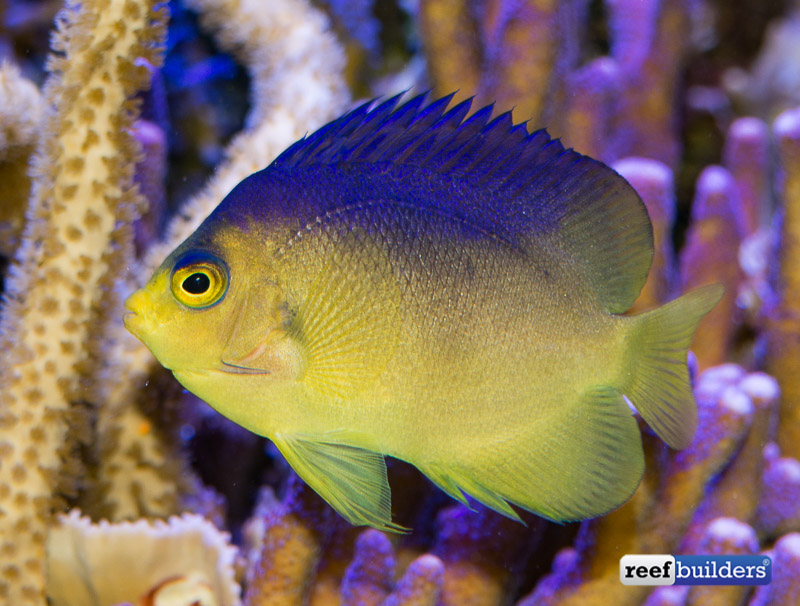Colin’s angelfish, Centropyge colini, is a unique pygmy angelfish that is among the least well known members of the genus. As I was ‘in the market’ for dwarf angelfish, I had the luxury position to consider all options for my reef tank. I have been in the marine aquarium hobby since 1990, and I do like most common fish, but this time I decided I wanted something different.
The only other angelfish in my tank is a regal angel, Pygoplites diacanthus, that has been in my care since 2003. I have gotten to know this specimen as a mild-mannered angelfish. As the newcomers would definitely be smaller, I did not expect any problems with the Pygo, as we call this fish.

Out of all interesting options, I decided to try to lay hands on Centropyge colini. Yes, I have read the articles on the difficulties with these fish. Because this fish is so secretive in the wild, they often suffer from damages occurred from collection. Centropyge colini is not easy to find in the trade, but I made the challenge even larger.
I wanted to avoid getting them from the Philippines or Indonesia. Although both countries are also the home countries of some great exporters, getting these fish from there would most likely increase the risk on difficulties as fishing with methods such as cyanide is unfortunately still too common in those areas in the world.

Every now and then, some Centropyge colini from other areas such as Fiji trickle in. My two fish came in together with a large shipment of fish and corals from Walt Smith, Fiji. I have mentioned the fish acclimation box I use in some other articles, but in this case, I felt more care was needed. So I put both in a 60 liter system I have running with some algae and hiding places to first be able to observe them. Also, I was ready to treat them for any diseases or parasites if the necessity arose.
After a few days, one of the fish started to become interested in the different foods I offered. High quality frozen lobster eggs, Mysis, live Mysis and live Artemia did get them started. After the first fish started to eat, the other one followed relatively quickly.

After just trying to gut load the fish, I gave them their first freshwater bath. A few days later, I did bathe them again. I kept both fish for one more week in this small tank, of course while feeding them a lot and keeping the water chemistry on par levels by replacing half of the water with water from my reef tank every few days.
Then I put them in the fish acclimation box. Here their mild manners disappeared in a few days and one started chasing the other. Before any damage occurred, I set them free in my reef tank. I got these fish in August 2015 and until now they have been doing fine. At first, the skin did not appear as I want my fishes’ skin to appear: ‘glowing’ with vibrant colours. I attribute this to a suboptimal condition of the fish.
As I did not think this case was serious enough to treat them, I let their immune systems deal with this condition. Of course, I also keep some cleaner shrimp in the reef. I value these because I have noticed that fish – when they are able to visit some kind of cleaner – seem to be more relaxed. Stress leads to reduced immune systems.
I try to understand my fish and their needs in order to have healthier fish.I have only occasionally seen them being cleaned but after a few months they started to become fatter and also I have noticed that the skin started to look more as I wanted it to look.
On their behavior I have noticed the following: they are far more docile than most other dwarf angels. I have kept multibar angelfish, Paracentropyge multifasciata, in the past and while those fish have a name for being docile, they are far bolder than Colin’s angelfish.

My two fish were no real pair but with the space and all the hiding places in my reef tank, they just tolerate each other. When they met in the tank, they just ignored each other or tried to impress each other with their fins.
The last few weeks this mild aggressiveness seems to decline. I also see them sometimes swimming around each other in a way similar to the way courting dwarf angels do. I hope they will develop into a true pair.
As far as them being safe with corals: I don’t mind my fish nipping a bit, as long as they don’t kill corals. I have experienced these fish to be quite mild mannered on the corals and great inhabitants of a community reef tank.




